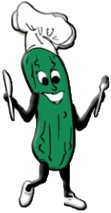 |
 The Virtual Corkscrew Museum's Weekly Newspaper |
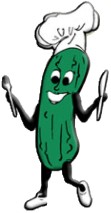 |
 |
 The Virtual Corkscrew Museum's Weekly Newspaper |
 |
|
Sunday, August 19, 2007 |
Number 474 |
Food Tools
For Fruits and Nuts
At first glance this appears to be another cork gripper. It advertises "Drink Molinari Vermouth" so a cork grip sounds likely. However, the inventor only specified knife, nut cracker, and grape scissors in his "Combination Table Article" patent.
Markings
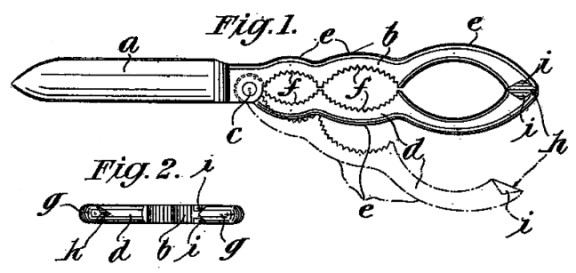
A British patent for he combination table article was applied for by Joseph Quitadamo, an Italian living in London, on February 21, 1924. He wrote "This invention relates to an improved combination article for table use comprising a fruit or the like knife, nut-crackers and snippers or scissors for grapes and the like." Patent No. 223,478 was completed on October 23, 1924.
Grape Scissors
Cheese Knobs
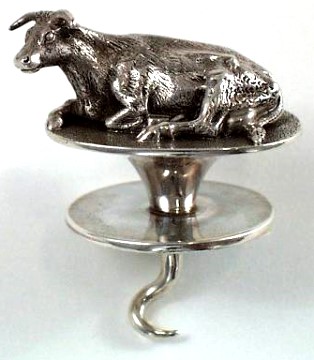
A corkscrew with ornamental handle used on cheese balls. It has a Gorham 1880 mark and is approximately 2" high by 1 3/4" wide.
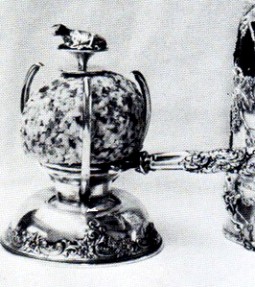
Gorham Cheese Knob in Cheese Ball
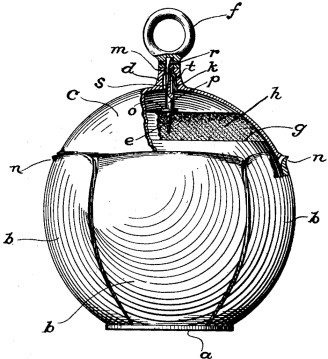
This catalog page appeared in the May 7, 2006 issue of The Weekly Screw:
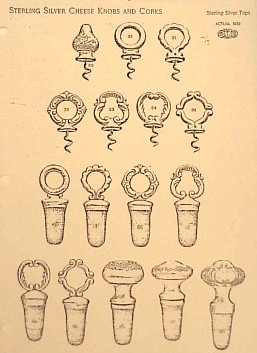
Sterling Silver Cheese Knobs and Corks

A Cheese Knob marked GORHAM (from the collection of Bert Giulian)
Cheese knobs from the Bull collection

U. S. Patent No. 826,790, July 24, 1906
In Ormand Lissak's 1906 "Holder for Cheeses" patent, there is a screw with a ring at the top which threads into the top of a cheese ball and is used to lift the cover and the top of the cheese. Lissak wrote "the cover consists of the hollow spherical segment c, to which is secured or attached lug d, bored as shown at m, e is a screw of the ordinary wood-screw or of the cork-screw type.
Olive & Pickle Forks
Edward Menkin's March 2, 1909 U. S. Patent No. 914,060 incorporates a corkscrew like device for stabbing and grabbing "round or spherical objects". Although the title of his patent his "Olive and Pickle Fork", he notes that it can be used remove, "pickled onions, cherries and similar fruits or vegetables from jars and receptacles."
Menkin says his twisted wires form on the end a "hook-grab, each of which is of a spiral or a cork-screw shape."
In Frederick Bignold's invention, we find another pickle fork. This one is part of a rather unusual elaborately designed "Combination Implement". And - in his design - is a genuine corkscrew for removing corks from bottles. Other tools include "a clamp, wrench, nut-cracker, lamp-chimney cleaner, pickle fork, greaser, torch, nail-file, cartridge-extractor".
Figure 1 shows the tool in cork removal mode. Figure 2 is the tool folded and figure three shows it arranged for use as a "pickle-fork" etc.
The Nebraska resident was granted U. S. Patent No. 631,247 on August 15, 1899.
A tool with an interesting twist is John Kroenlein's "Food Spear". His invention was patented on November 25, 1952 (U. S. No. 2,619,371). Kroenlein wrote "With large pieces or types of food, the wire will be rotated by the shaft in a corkscrew fashion into the food to impale the food on the pin." The purpose of the corkscrew-like twist on the pin is to "limit the extent of impalement of a piece of food on the pin, while assisting in the impalement and retention of the food on the pin."
One of the patents cited in Kroenlein's application is H. J. White's "Dried Fruit Looseners" U. S. Patent No. 166,171 of July 27, 1875. This also has an interesting twist designed for a grocer to loosen up fruit compacted in barrels and boxes.
Four can / bottle openers with corkscrews and cocktail forks (for pickles, olives, cherries, pearl onions, and the like). The top one is marked EASY GRIP 4 In 1 MADE IN U.S.A. The third one is marked ROBERTS MADE IN U.S.A.
Culinary Tool
On the Zelco.com website we find "Food Tool. The Multi-Purpose Culinary Tool, Extraordinaire. This lightweight, die-cast aluminum utensil is an essential tool for camping, picnicking, kitchens, bars, patios, and boats. It includes: a stainless steel corkscrew that is Teflon - coated so it can twist smoothly into cork; a handy, easy to use bottle opener; and --in high quality, hardened stainless steel -- a sharp laser-edge knife, a can opener, and a screwdriver. Removable, emergency salt and pepper shakers have snap-lids to keep out moisture. And this culinary tool extraordinaire closes down into a compact 5.7" for easy storage and portability. Indispensable for travel. Color: Silver Dimensions: 5 3/4" x 1/2" x 3/4" or 146 x 12 x 19mm."
The Zelco Food Tool was patented (above) by Henry Zeller and Stuart Harvey Lee on October 3, 2000. U. S. Patent No. 6,125,489 was assigned to Zelco Industries of Mount Vernon, New York. The patent abstract is "A combination food and beverage tool includes a housing, at least one of a blade and a can opener slidably mounted within the housing and a slide mechanism for slidably moving the at least one of the blade and can opener between a first position in which the at least one of the blade and can opener is recessed within the housing and a second position in which at least a portion of the at least one of the blade and can opener is exposed outside the housing. At least one container has a first end, and a second end, and a removable lid. The first end of the container is mounted within the housing, the lid covering the second end of the container."
Elements of Ernst Klinger's German Patent No. 2,443,703 of March 23, 1976 can be seen in the Zelco tool including the removable salt and pepper shakers. Klinger's patent is for a Vielzwek-Tisch und Taschenkombi.
Eyes on Potatoes
A French Potato ruffle from the collection of Bert Giulian. Bert says "The worm is presumably to pick out the eyes of the Potatoes."
Bert's submission prompted us to search for potato utensil patents. Our quest led us to John Forster's U. S. Patent No. 1,172,695 for a "Vegetable-Slicer" issued February 22, 1916. John's drawing shows a potato being cut into an ornamental corkscrew like garnishing slice. He wrote "The cutter is illustrated in operation ... the unsliced portion of the potato, the spiral or cork-screw like slice produced by the progressive movement of the improved slicing device."
A more recent patent has a suggested variations of a holding tool. One is "a cork screw member. In use, the potato, for example, is rotated while inserting the corkscrew member. This secures the potato in position while peeling it." U. S. Patent No. 6,659,522 was issued December 9, 2003 to Halle Anne Byth for her "Fruit and Vegetable Holding Utensil" (for peeling).
Now let us suppose your bull, Ferdinand, attempts to swallow a potato or an apple and it gets stuck in his throat. What do you do? Samuel Cochrane of Arlington, Virginia came up with the answer more than a century ago with his "Veterinary Surgical Instrument". Samuel's patent is interesting food for the voracious reading appetite:
"The special object of the invention is to withdraw, without injury to the animal, a vegetable or fruit which may have become lodged in his throat below the muscles with which he swallows. Heretofore a straight piece of wood or other substance has been employed to push the obstruction down the animal's throat; but in some cases it destroys life, while it is attended with risk and more or less injury in all cases. The fruit or vegetable has slipped past the muscles of deglutition in a nearly or quite entire state, so that it is not in a proper condition to be forced down in to the stomach, and should be brought back into the mouth for mastication and comminution. This is promptly and completely effected by my invention."
The operation of the tool should be obvious to the reader in the above drawing. Samuel's claim is "A sharp-pointed spiral or corkscrew, combined, slidingly and rotatingly with a surrounding tube, the latter adapted to be moved up against a potato or analogous substance in the throat of an animal, and the former to rotate until it takes a sufficient hold, as and for the purpose specified."
U. S. Patent No. 319,454 was granted June 9, 1885.
Over a hundred years later, McPherson, Saye, and Reddick obtained a patent for a tool having properties very similar to Cochrane's 1885 design. However, the threesome did not intend their tool for use in removing potatoes stuck in an animals throat, rather their's is intended for use as a surgical instrument. Their "Method of Using a Coil Screw Surgical Retractor" was granted U. S. Patent No. 5,573,496 on November 12, 1996.
OK, so readers may think we're going off the deep end but when we come across these things that have a corkscrew look, we can't help but include them (hey, you may run across one and wonder "what the heck is that"). The drawing pictured above had a catchy title "Device for Curing Chickens of the Gapes". Yep, you shove that spiral down the chicken's throat and twist it to extract worms stuck there. Robert Walker was granted U. S. Patent No. 343,145 on June 1, 1886.
This tool from Taiwan can remove a bottle cap, open a can, uncork a bottle, peel fruit or vegetables, and be used as a fruit zester /grater.
Next Week: Corn Screws and Butter Picks
|
©2007 Don Bull, Editor |